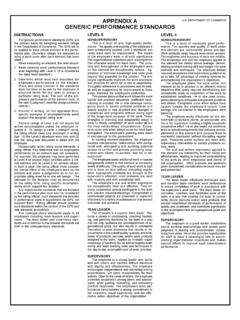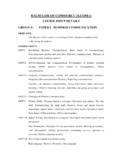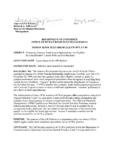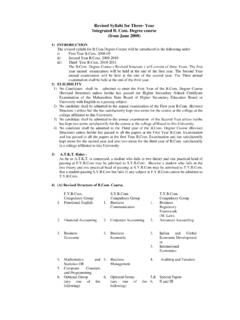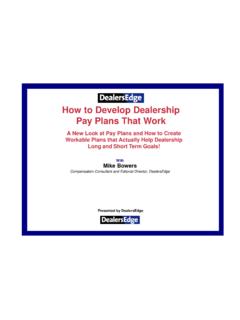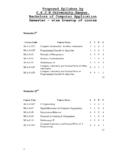Transcription of OCR LEVEL 3 CAMBRIDGE TECHNICAL - ocr.org.uk
1 E-commerceA/601/7313 LEVEL 3 unit 6 GUIDED LEARNING HOURS: 60 unit CREDIT VALUE: 10 OCR LEVEL 3 CAMBRIDGE TECHNICALCERTIFICATE/DIPLOMA 3 unit 6 AIM OF THE UNITB usinesses are constantly looking for ways to expand their business and increase their market presence. By taking their business online this could ensure they reach new markets and therefore increase their profits. This unit will provide the learner with the skills to research the benefits of having an e- commerce unit is to help the learner understand the technologies required for an e- commerce system. Learners will then learn the impact of e- commerce on an organisation and how this affects e- commerce in society. Finally they will be required to create a plan for an e- commerce LEVEL 3 unit 61 Know the technologies required for an e- commerce system2 Understand the impact of e- commerce on organisations 3 Understand the effects of e- commerce on society 4 Be able to plan e- commerce strategiesP1 describe the technologies required for e- commerce P2 explain the impact of introducing an e- commerce system to an organisationP3 explain the potential risks to an organisation of committing to an e- commerce systemP4 review the regulations governing e-commerceP5 examine the social implications of e- commerce on society P6 plan an e- commerce strategyM1 describe how organisations promote their business using e-commerceM2 explain solutions for the potential risks of using e- commerce M3 provide annotated planning documentation for your e- commerce strategyD1 compare the benefits and drawbacks of e- commerce to an organisationD2
2 Evaluate your e- commerce strategyLearning Outcome (LO) Pass Merit Distinction The assessment criteria are To achieve a merit the To achieve a distinction the pass requirements for evidence must show that, the evidence must show this unit . in addition to the pass that, in addition to the pass criteria, the learner is able to: and merit criteria, the The learner will: The learner can: learner is able to: ASSESSMENT AND GRADING CONTENTThe unit content describes what has to be taught to ensure that learners are able to access the highest which follows an details what must be taught as part of that area of which follows an is illustrative, it should be noted that where is used , learners must know and be able to apply relevant examples to their work though these do not need to be the same ones specified in the unit Know the technologies required for an e- commerce system Technologies hardware web server and specifications, monitor, keyboard, mouse, modem, network card software server, web browser, web creation and database creation software networking ports, protocols, TCP/IP domain names and registration programming MySQL, PHP, JavaScript.
3 HTML internet speeds and connections Understand the impact of e- commerce on organisationsAdvantages 24/7 opening global business opportunities start-up and running costs are low can be used to expand a retail business increased income customer information can be stored competitors can be monitored can be searched easily can be run from home can be managed easily ease of access by customers not able to see products product description maintenance delivery costs and other issues customers are unsure whether to trust the business lack of personal attention global legislation security. Promotion of Business search engine optimisation, meta tags, search results listing pop-ups banners and advertising forums, newsgroups, blogs and vlogs spam direct marketing website being Understand the effects of e- commerce on society Risks hacking viruses identity theft passwords fraud returns firewalls virus software SSL, HTTPS data security methods returns policy secure payment Be able to plan e- commerce strategiesLegislation and Regulations Data Protection Act 1998 Computer Misuse Act 1990 Consumer Credit Act 1974 Trading Standards Freedom of Information Act 2000 Copyright legislation Distance selling 2000 e- commerce regulations Implications bricks and clicks high street stores having an e- commerce facility advantages to customers 24/7, shopping from home.
4 Access to goods globally disadvantages to customers card details stolen, products not as described, delivery issues isolation/lack of social interaction5e- commerce LEVEL 3 unit 6 customer service ease of ordering, delivery keeping up with technology in order to use e- commerce sites reduction in employment closure of high street Strategy client, purpose and target audience structure of website site plan, navigation components and facilities product information, ordering and payment services website hosting choice of ISP, reasons for choice advertising search engines, marketing costs setup, maintenance, security and advertising site map, content, storyboards assets image and product details house style and consistency business wider target audience more competitive easier stock control reduced overheads immediate stock/availability check access to goods globally price fraud delivery issues internet access choice increased returns.
5 Payment Systems services available PayPal, NoChex, credit or debit cards, review strategy details review documentation GUIDANCEKnow the technologies required for an e- commerce systemLearners should be encouraged to visit a range of e- commerce sites to help them understand what e- commerce is. As a group they could be encouraged to identify the hardware and software components required in order to have an e- commerce site and discuss these findings. The tutor should explain the TECHNICAL terminology and protocols that are applicable to the unit as it is essential that learners understand the term TCP/IP and what is meant by ports and protocols. To reinforce this they could be asked to identify a range of protocols from a suggested list of websites. Learners are also required to understand domain names and the registration process, as a group they could be provided with exercises to identify the parts of a domain name.
6 They should also look at how they can register or check domain names without physically having to register or need to understand internet speeds, they could use an online speed checker to find out the speed of the website they are using and should then as a group discuss the advantages and disadvantages of having a fast speed/slow speed. Learners should be encouraged to research W3C and what this the impact of e- commerce on organisations Learners as a group could discuss the advantages and drawbacks of an organisation having an e- commerce system. The organisation used for discussion could be one provided to them or one they have found when looking at different e- commerce sites. They should be encouraged to identify as many advantages and drawbacks as they can. They may even discuss how the drawbacks could be overcome or considered to reduce the are required to understand how an e- commerce system could be promoted, which can be done by using different search engines, pop-ups, banners and advertising, forums, newsgroups, blogs and vlogs etc to see how they work and how they help promote e- commerce websites.
7 This should be carried out as individual research and group discussion to enable learners to fully consider all aspects. Understand the effects of e- commerce on society Learners need to understand the potential risks for e- commerce systems, which should be set initially as research activities. Learners could brainstorm risks and then discuss as a group to identify risks that they may not have considered and look at the different aspects and implications of learners could then be encouraged in small groups to further research risks allocated to them to see if they can find an example of when the risk has happened or may have been avoided, as well as find a solution or preventative method. The small groups/pairs could then be encouraged to provide feedback to the main able to plan e- commerce strategiesLearners are required to understand the different legislations associated with having an e- commerce site. They should be taught the different legislation and regulations that apply to e- commerce , the purpose and benefits of them and they should be encouraged to refer to the relevant websites and find out more details as to what the legislations specifically covers.
8 Activities to help them research the legislations could be provided along with a quiz to check that they have understood what they have found need to understand social implications of the increasing move towards becoming an e- commerce society, which could be set as research activities. Learners could be asked to identify as many social implications as they can and these can then be distributed to learners in small groups or pairs for further research. The small groups/pairs could then be encouraged to provide feedback to the main group. Learners working in small teams could also be asked to identify a selection of benefits and drawbacks for customers of using e- commerce should be encouraged to research a selection of e- commerce website interfaces. They should then use an example business (this could be provided) to help them research what the business is, the purpose and target audience for the website, how the business is structured online, creating an outline site plan to show the structure, how it is promoted and hosted.
9 7e- commerce LEVEL 3 unit 6 Learners could be encouraged to create planning documentation and the relevant details that would be needed, for one of the webpages that they have researched. They could also do some research into the costs involved in creating an e-ccommerce system and the security measures that should be put in place. Once the learners have carried out their research they could provide feedback to the group informing them of their findings and also reviewing the site plans and documentation created by others. One final group discussion would be to evaluate the group s findings to ensure that the criteria identified would be suitable for a commercial ASSESSMENT SCENARIOS AND TASK PLUS GUIDANCE ON ASSESSING THE SUGGESTED TASKSA ssessment Criterion P1 The assessment criterion P1 could be evidenced by the use of a report, leaflet or presentation delivered by the learner that could be supported by tutor observation and/or recorded evidence.
10 The learner is required to describe the technologies required for an e- commerce system, as outlined in the teaching content. Assessment Criteria P2, M1 The assessment criterion P2 could be evidenced by the use of a report, leaflet or presentation delivered by the learner that could be supported by tutor observation and/or recorded evidence. The learner is required to explain the impact of introducing an e- commerce system on an organisation (the organisation details could be provided). The learner must explain at least four impacts from both the advantages and disadvantages sections in the teaching merit criterion M1 could be evidenced by the learner describing and providing a detailed description how an organisation (same business as used for assessment criterion P2) can promote their business using e- commerce . They must provide examples which could be evidenced by screen prints. The learner must include at least four methods listed in the teaching content.










